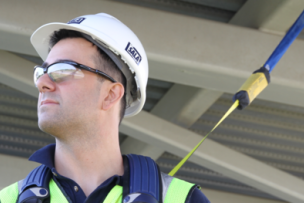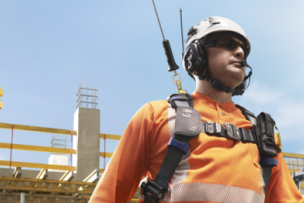The number of workplace injuries and related costs has remained virtually unchanged year over year.
As recently as 2019, there were a reported 2.8 million workplace injuries and illnesses costing employers approximately $171 billion, including costs associated with wage and productivity losses, and medical and administrative expenses. And what’s more, up to 90 percent of those injuries can be attributed to human error.
Safety and the Connected Workplace
Yet even as many workplaces become more connected digitally, allowing employees to collaborate and work remotely, and allowing for smarter workflows, there are still opportunities to use technology to improve workplace safety. Doing so can improve productivity and bring the peace of mind that your workers and worksites are protected.
With this idea in mind, MSA Safety recently unveiled the MSA+ subscription program and the ALTAIR io 4 Gas Detector, which when combined can help improve worker safety and productivity in manufacturing facilities.
Unveiled at the National Safety Council’s Safety Congress & Expo in Orlando, Florida, the new offering combines hardware and software to deliver a range of capabilities not previously available with a stand-alone gas detector.
The ALTAIR io 4 Gas Detection Wearable device, which will be available in early 2022, transmits real-time data, such as critical gas detection readings and location information, to a new cloud-based software platform. This allows safety managers to make use of real-time remote monitoring using global cellular connectivity and GPS location technology. MSA’s Grid software services allow for fleet management, real-time remote monitoring and incident reporting. Through the new MSA+ subscription program, the solutions are bundled to simplify workflows and ease the burden of safety program management for safety professionals.
Personal protective equipment hasn’t traditionally incorporated a technology component that helps to mitigate workplace injuries, notes Rob Senko, a regional segment manager for industrial markets at MSA.
An adaptive connected solution such as the MSA+ program and its pairing with the ALTAIR io 4 Gas Detector, not only connects workers and worksites but also provides reliable actionable data that allows safety managers to create safer and more efficient work environments, he says.
“What really makes up the connected work platform is three things: hardware, connectivity and software,” Senko says.
“The hardware is the ALTAIR io 4, which produces data as it’s worn by a worker, and the veins of the connectivity connect that data to the cloud in real time. The brain of the operation is the MSA grid, which provides accurate insights to safety managers, making it easier for them to manage their safety program and actually know what’s going on within their site. And they can use those insights to take action to make their safety program better.”
Read more: Virtual Safety Training: How MSA Uses Technology to Safeguard Your Workers
Embracing Behavior-Based Safety
Using technology for safety in the workplace not only improves the health outlook for employees, it also makes companies more agile and productive.
By monitoring and studying worker behavior, safety managers can arm themselves with the information they need to influence employee actions toward safer outcomes, ideally preventing a serious injury or accident before it occurs.
It’s commonly known that the unsafe behavior that led to an accident can often continue after an accident occurs, suggesting that workers to change their unsafe habits is difficult.
A connected system that’s constantly gathering data means safety managers no longer need to use spreadsheets and databases to gather and analyze safety data.
Instead, an intuitive dashboard with the real-time status of workers and devices helps managers quickly understand and react to information and understand patterns of behavior. A technology-first approach can save time and free up managers to build behavior-based safety programs.
The platform makes safety managers’ lives easier by offering “peace of mind,” Senko says.
“The way the product functions, along with the grid and the intuitive nature of the software, really provides the visibility that safety managers need to manage large teams of workers,” he says.
“We’re all striving for behavior-based safety; it’s a hard thing to achieve. We want to foster that culture of safety through the intuitive nature of the product that we’re building, and we can do that by giving safety managers visibility—the real-time aspect of the product, the GPS location that we’ve built in—and knowing how someone is actually using the units,” Senko adds.
“If your guys out there shut a unit down and it goes into alarm, safety managers need to know that,” he continues. “They need to be coaches and they need to educate workers on why it’s important to follow their safety procedures. That’s what companies want to do. It has to be a core value, and the product allows them to do that.”
Read more: Machine Safety: Here’s Why You Should Be Taking It Seriously
Creating Safer, More Efficient Environments
The ALTAIR io 4 is MSA’s first connected safety device, but it won’t be the last. As the company continues to deliver on its mission of protecting people at work, it plans to roll out new devices connected to the MSA+ program.
“With the millions of workplace injuries each year and countless lost hours of productivity, you need advanced technology tools that can build connections between worksites and workers to create an adaptive safety program,” Senko says.
“Now and into the future, more connections can help provide reliable actionable data, allowing safety managers to help create safer and more efficient work environments, building the connections between people and places, and helping to drive a transformation of safety culture.”
For more information about the MSA+ connected platform, please visit this site.
How are you incorporating technology into your safety programs? What benefits have you seen? Share your thoughts and insights in the comments below.





Talk to Us!
Leave a reply
Your email address will not be published. Required fields are marked *